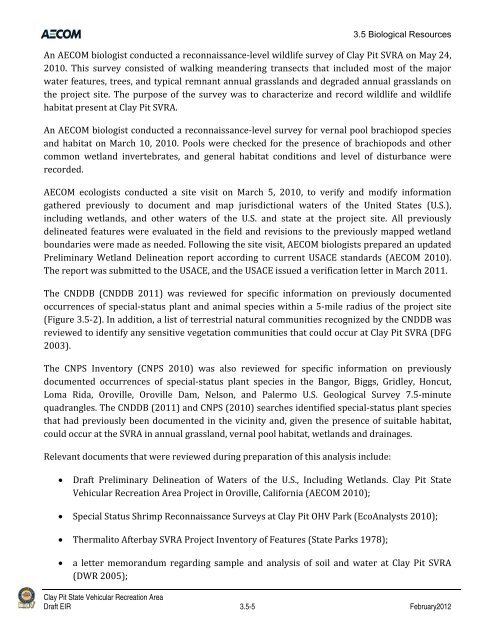Draft Environmental Impact Report - California Off Highway Vehicle ...
Draft Environmental Impact Report - California Off Highway Vehicle ...
Draft Environmental Impact Report - California Off Highway Vehicle ...
You also want an ePaper? Increase the reach of your titles
YUMPU automatically turns print PDFs into web optimized ePapers that Google loves.
3.5 Biological Resources<br />
An AECOM biologist conducted a reconnaissance‐level wildlife survey of Clay Pit SVRA on May 24,<br />
2010. This survey consisted of walking meandering transects that included most of the major<br />
water features, trees, and typical remnant annual grasslands and degraded annual grasslands on<br />
the project site. The purpose of the survey was to characterize and record wildlife and wildlife<br />
habitat present at Clay Pit SVRA.<br />
An AECOM biologist conducted a reconnaissance‐level survey for vernal pool brachiopod species<br />
and habitat on March 10, 2010. Pools were checked for the presence of brachiopods and other<br />
common wetland invertebrates, and general habitat conditions and level of disturbance were<br />
recorded.<br />
AECOM ecologists conducted a site visit on March 5, 2010, to verify and modify information<br />
gathered previously to document and map jurisdictional waters of the United States (U.S.),<br />
including wetlands, and other waters of the U.S. and state at the project site. All previously<br />
delineated features were evaluated in the field and revisions to the previously mapped wetland<br />
boundaries were made as needed. Following the site visit, AECOM biologists prepared an updated<br />
Preliminary Wetland Delineation report according to current USACE standards (AECOM 2010).<br />
The report was submitted to the USACE, and the USACE issued a verification letter in March 2011.<br />
The CNDDB (CNDDB 2011) was reviewed for specific information on previously documented<br />
occurrences of special‐status plant and animal species within a 5‐mile radius of the project site<br />
(Figure 3.5‐2). In addition, a list of terrestrial natural communities recognized by the CNDDB was<br />
reviewed to identify any sensitive vegetation communities that could occur at Clay Pit SVRA (DFG<br />
2003).<br />
The CNPS Inventory (CNPS 2010) was also reviewed for specific information on previously<br />
documented occurrences of special‐status plant species in the Bangor, Biggs, Gridley, Honcut,<br />
Loma Rida, Oroville, Oroville Dam, Nelson, and Palermo U.S. Geological Survey 7.5‐minute<br />
quadrangles. The CNDDB (2011) and CNPS (2010) searches identified special‐status plant species<br />
that had previously been documented in the vicinity and, given the presence of suitable habitat,<br />
could occur at the SVRA in annual grassland, vernal pool habitat, wetlands and drainages.<br />
Relevant documents that were reviewed during preparation of this analysis include:<br />
<strong>Draft</strong> Preliminary Delineation of Waters of the U.S., Including Wetlands. Clay Pit State<br />
Vehicular Recreation Area Project in Oroville, <strong>California</strong> (AECOM 2010);<br />
Special Status Shrimp Reconnaissance Surveys at Clay Pit OHV Park (EcoAnalysts 2010);<br />
Thermalito Afterbay SVRA Project Inventory of Features (State Parks 1978);<br />
a letter memorandum regarding sample and analysis of soil and water at Clay Pit SVRA<br />
(DWR 2005);<br />
Clay Pit State Vehicular Recreation Area<br />
<strong>Draft</strong> EIR 3.5-5 February2012








